I'm trying to get a Gesture Recognizer to work on unity 3D. The script let's me choose if I'm recording a gesture or comparing to existing ones if not recording.
The problem is
On the first run, it works perfectly: It lets me draw and record gestures and then, after disabling recording, it compares to existing ones to look for a match on a list (templates.templates).
But then after I close the game and re-open it, it debugs "loading successful" and I can see the list of the templates in the Inspector, but it returns an error of NullRefferenceException for the templates or current gesture. I'm losing my mind here. Can you help me notice what behaves differently from the first run and second (after loading the templates from json file) and figure this thing out?
The script is as follows (I serialized every private thing just because...):
using System.Collections;
using System.Collections.Generic;
using UnityEngine;
using System;
using System.IO;
//******************************************* Gesture Recognizer *********************************************//
//
// Author: Andres De La Fuente Duran
//
// Use: This script can simply be attached to a camera to function.
// It allows for recording of 2D 'gestures', in this case meaning a set of points
// representing a continuous motion of the mouse (or touch input).
// It also allows for testing 'gestures' against a collection of templates created
// with this very same script.
//
// Template gestures are saved in a JSON file and loaded into a list at start.
//
// The way the recognition works is that a list of points is recorded (relative to
// the location of the initial click as (0,0)), scaled to a square resolution of
// choice, reduced by interpolation to a set number of points, and then compared
// to gestures already processed by this script.
//
// This is built for maximum customizability, so you can change the number of points
// allowed when recording, the number of points once reduced, the rate of sampling,
// and the square ratio gestures are scaled to. Recording the gestures and testing
// can be done easily by swithching the 'recording' boolean variable.
//
// Some additional notes: Because the origin of each gesture is the initial
// point, and comparison follows points in order of
// recording, directionality is captured by this
// solution. The gestures do not have to be wildly
// different for the recognition to be reliable.
//
// However, you can turn on 'anomaliesTesting' to
// weight more heavily sudden differences in gestures
// than constant differences to allow for similar
// gestures with small modifications or flares.
//****************************************** Recognizer Class ****************************************************//
//
// Use: Stores all information for the current gesture being recorded, the existing gestures,
// the conditions selected by an editor user, and variables needed to perform recognition.
// This is the central class with most of the functionality in the script.
//
// Fields:
// Editor Controlled............................................................................
//
// recording: boolean to control whether to save a gesture or try to recognize it
//
// anomaliesTesting: boolean to control whether to weight sudden differences during
// comparison more than other differences
//
// pointsPerGesture: the size of the array of points stored for each gesture
//
// templateSaveName: the string name of the gesture to be saved when recording
//
// samplingRate: time interval between samples while recording
//
// maxPointsAllowed: the maximum number of points that will be recorded
//
// standardRatio: the size of one side of the square that points will be scaled to
//
// devTightness: the number of deviations from the average difference between the points
// of two gestures that are allowed before they are weighted more
//
// anomaliesFactor: how much extra to weight the differences that surpass the devTightness
//
// Control Flow................................................................................
//
// gestureStarted: boolean to execute code to start gesture and to avoid starting anew
//
// gestureComplete: boolean to execute recording of gesture until complete
//
// inputReady: boolean to prevent execution of anything until input is lifted
// so as not to start gestures immediately after one is complete
//
// Recording and Recognizing...................................................................
//
// gestureFileName: JSON file to load saved gestures from as templates for recognition
//
// startPoint: the initial point from which to calculate every other point
//
// currentPoint: the last point recorded
//
// currentGesture: the object containing the recorded gesture for current execution
//
// currentPointList: list of points as they are recorded
//
// reducedPoints: array of points for after scaling and mapping of currentPointList
//
// templates: object to store list of template gestures
//
// tempTime: time since last sample
//
// Methods: Documentation is above each significant function
public class GestureRecognizer : MonoBehaviour {
public bool recording = true;
public bool anomaliesTesting = false;
public string templateSaveName;
public int pointsPerGesture = 30;
public float samplingRate = 0.01f;
public bool limitSamples = false;
public int maxPointsAllowed = 100;
public float standardRatio = 100f;
public float devTightness = 1f;
public float anomaliesFactor = 5f;
[SerializeField]private bool gestureStarted;
[SerializeField] private bool gestureComplete;
[SerializeField] private bool inputReady;
[SerializeField] private string gestureFileName = "gestures.json";
[SerializeField] private TwoDPoint startPoint;
[SerializeField] private TwoDPoint currentPoint;
[SerializeField] private DrawnGesture currentGesture;
[SerializeField] private List<TwoDPoint> currentPointList;
[SerializeField] private TwoDPoint[] reducedPoints;
[SerializeField] private GestureTemplates templates;
[SerializeField] private float tempTime = 0f;
private void Awake()
{
}
void Start () {
LoadTemplates();
varInitialization();
}
#region variable initialization and reset
private void varInitialization()
{
currentPoint = new TwoDPoint(0, 0);
startPoint = new TwoDPoint(0, 0);
currentPointList = new List<TwoDPoint>();
currentPointList.Add(new TwoDPoint(0, 0));
reducedPoints = new TwoDPoint[pointsPerGesture];
for (int i = 0; i < pointsPerGesture; i++)
{
reducedPoints[i] = new TwoDPoint(0, 0);
}
gestureStarted = false;
gestureComplete = false;
inputReady = false;
currentGesture = new DrawnGesture("currentGesture", pointsPerGesture);
}
private void varReset()
{
for (int i = 0; i < pointsPerGesture; i++)
{
reducedPoints[i].SetX(0);
reducedPoints[i].SetY(0);
}
currentPointList.Clear();
currentPointList.Add(new TwoDPoint(0,0));
gestureStarted = false;
gestureComplete = false;
}
#endregion
void Update() {
tempTime += Time.deltaTime;
if (Input.GetMouseButton(0))
{
if (inputReady)
{
if (!gestureStarted)
{
gestureStarted = true;
StartGesture();
}
if ((!gestureComplete) && (tempTime > samplingRate))
{
tempTime = 0f;
ContinueGesture();
}
if (gestureComplete)
{
EndGesture();
}
}
} else
{
if (gestureStarted)
{
EndGesture();
}
inputReady = true;
}
}
//******************************************
// Save and Load Gestures
//
// SaveTemplates
// use: writes templates to json file
// LoadTemplates
// use: called on start to read json templates
// object from file if it's there
[SerializeField]
private void SaveTemplates()
{
string filePath = Application.dataPath + "/StreamingAssets/" + gestureFileName;
string saveData = JsonUtility.ToJson(templates);
File.WriteAllText(filePath, saveData);
Debug.Log("Template Saved!");
}
[SerializeField]
private void LoadTemplates()
{
templates = new GestureTemplates();
string filePath = Path.Combine(Application.streamingAssetsPath, gestureFileName);
if (File.Exists(filePath))
{
string data = File.ReadAllText(filePath);
templates = JsonUtility.FromJson<GestureTemplates>(data);
Debug.Log("Templates Loaded!");
}
}
//***************************************
// StartGesture
//
// use: Set up recording of gesture by
// setting the start point and control bool.
// Called when player first clicks.
[SerializeField]
private void StartGesture()
{
Debug.Log("gesture started");
startPoint.SetX(Input.mousePosition.x);
startPoint.SetY(Input.mousePosition.y);
gestureComplete = false;
}
//***************************************
// ContinueGesture
//
// use: Update min and max x and y values for
// the current gesture being recorded
// and add the new point to the list.
// Called while player holds input down.
[SerializeField]
private void ContinueGesture()
{
currentPoint.SetX(Input.mousePosition.x - startPoint.GetX());
currentPoint.SetY(Input.mousePosition.y - startPoint.GetY());
currentPointList.Add(new TwoDPoint(currentPoint.GetX(), currentPoint.GetY()));
if (currentPoint.GetX() > currentGesture.GetMaxX())
{
currentGesture.SetMaxX(currentPoint.GetX());
}
if (currentPoint.GetX() < currentGesture.GetMinX())
{
currentGesture.SetMinX(currentPoint.GetX());
}
if (currentPoint.GetY() > currentGesture.GetMaxY())
{
currentGesture.SetMaxY(currentPoint.GetY());
}
if (currentPoint.GetY() < currentGesture.GetMinY())
{
currentGesture.SetMinY(currentPoint.GetY());
}
if (limitSamples && currentPointList.Count >= maxPointsAllowed)
{
gestureComplete = true;
Debug.Log(message: "Gesture Complete!");
}
}
//***************************************
// EndGesture
//
// use: Resets control bools and other variables
// records gesture to the templates object
// or calls recognition.
// Called when max recording points reached.
[SerializeField]
private void EndGesture()
{
if (inputReady) inputReady = false;
gestureStarted = false;
gestureComplete = true;
Rescale(currentGesture);
MapPoints(currentGesture);
if (recording)
{
currentGesture.SetName(templateSaveName);
templates.templates.Add(new DrawnGesture(currentGesture.GetName(), pointsPerGesture, currentGesture.GetMaxX(), currentGesture.GetMaxY(),
currentGesture.GetMinX(), currentGesture.GetMinY(), currentGesture.GetPoints()));
} else
{
DrawnGesture m = FindMatch(currentGesture, templates);
Debug.Log(m.GetName());
}
varReset();
}
[SerializeField]
private void OnApplicationQuit()
{
SaveTemplates();
}
//***************************************
// Rescale
//
// use: scales recorded list of points to a square field
// of a chosen size by multiplication of the factor
// of the desired size it already is
// Called on every gesture after recording
[SerializeField]
private void Rescale(DrawnGesture gesture)
{
float scale = 1f;
float xrange = gesture.GetMaxX() - gesture.GetMinX();
float yrange = gesture.GetMaxY() - gesture.GetMinY();
if (xrange >= yrange)
{
scale = standardRatio / (gesture.GetMaxX() - gesture.GetMinX());
} else
{
scale = standardRatio / (gesture.GetMaxY() - gesture.GetMinY());
}
if (scale != 1)
{
foreach (TwoDPoint point in currentPointList)
{
point.SetX(point.GetX() * scale);
point.SetY(point.GetY() * scale);
}
}
}
//***************************************
// MapPoints
//
// use: maps the list of recorded points to a desired
// number of points by calculating an even distance
// between such a number of points and interpolating
// when that distance is reached upon traversal of the
// list
// Called after scaling on every gesture
//
// param: gesture: the object to store the new array
[SerializeField]
private void MapPoints(DrawnGesture gesture)
{
reducedPoints[0].SetX(currentPointList[0].GetX());
reducedPoints[0].SetY(currentPointList[0].GetY());
int newIndex = 1;
float totalDistance = TotalDistance();
float coveredDistance = 0;
float thisDistance = 0;
float idealInterval = totalDistance / pointsPerGesture;
for (int i = 0; i < currentPointList.Count - 1; i++)
{
thisDistance = PointDistance(currentPointList[i], currentPointList[i + 1]);
bool passedIdeal = (coveredDistance + thisDistance) >= idealInterval;
if (passedIdeal)
{
TwoDPoint reference = currentPointList[i];
while (passedIdeal && newIndex < reducedPoints.Length)
{
float percentNeeded = (idealInterval - coveredDistance) / thisDistance;
if (percentNeeded > 1f) percentNeeded = 1f;
if (percentNeeded < 0f) percentNeeded = 0f;
float new_x = (((1f - percentNeeded) * reference.GetX()) + (percentNeeded * currentPointList[i + 1].GetX()));
float new_y = (((1f - percentNeeded) * reference.GetY()) + (percentNeeded * currentPointList[i + 1].GetY()));
reducedPoints[newIndex] = new TwoDPoint(new_x, new_y);
reference = reducedPoints[newIndex];
newIndex++;
thisDistance = (coveredDistance + thisDistance) - idealInterval;
coveredDistance = 0;
passedIdeal = (coveredDistance + thisDistance) >= idealInterval;
}
coveredDistance = thisDistance;
} else
{
coveredDistance += thisDistance;
}
gesture.SetPoints(reducedPoints);
}
}
//***************************************
// FindMatch
//
// use: determines template gesture with the minimum
// average distance between points to the
// currently recorded gesture
// Called after finishing a gesture when not
// recording
//
// param: playerGesture: current gesture to be matched
// templates: object containting list of
// gestures to compare against
//
// return: returns gesture object of the minimum
// difference template
[SerializeField]
private DrawnGesture FindMatch(DrawnGesture playerGesture, GestureTemplates templates)
{
float minAvgDifference = float.MaxValue;
DrawnGesture match = new DrawnGesture("no match", pointsPerGesture);
foreach(DrawnGesture template in templates.templates)
{
Debug.Log(template.GetName());
float d = AverageDifference(playerGesture, template);
Debug.Log(d.ToString());
if (d < minAvgDifference)
{
minAvgDifference = d;
match = template;
}
}
return match;
}
//***************************************
// AverageDifference
//
// use: caluclates the average distance between
// the points of two gestures
//
// param: playerGesture: first to be compared
// template: gesture to be compared against
//
// return: returns float value of the average distance
// between points of two parameter gestures
[SerializeField]
private float AverageDifference(DrawnGesture playerGesture, DrawnGesture template)
{
int numPoints = playerGesture.GetNumPoints();
if (numPoints != template.GetNumPoints())
{
Debug.Log("Number of points differs from templates");
return -1f;
}
float totalDifference = 0;
for (int i = 0; i < numPoints; i++)
{
totalDifference += PointDistance(playerGesture.GetPoints()[i], template.GetPoints()[i]);
}
return (totalDifference / numPoints);
}
//***************************************
// AverageDistanceWithAnomalies
//
// use: calculates the average difference between
// the points of two gestures but weighing
// those which deviate significantly by
// multiplying them
// Both the tightness of this and the factor
// of multiplication are customizable
// above
//
// param: playerGesture: first to be compared
// template: gesture to be compared against
//
// return: returns float value of the average distance
// between points of two parameter gestures
// with weights
[SerializeField]
private float AverageDifferenceWithAnomalies(DrawnGesture playerGesture, DrawnGesture template)
{
int numPoints = playerGesture.GetNumPoints();
if (numPoints != template.GetNumPoints())
{
Debug.Log("Number of points differs from templates");
return -1f;
}
float totalDifference = 0;
float[] sampleDifferences = new float[numPoints];
float[] sampleDeviations = new float[numPoints];
float standardDev = 0;
for (int i = 0; i < numPoints; i++)
{
float thisDistance = PointDistance(playerGesture.GetPoints()[i], template.GetPoints()[i]);
sampleDifferences[i] = thisDistance;
totalDifference += thisDistance;
}
float average = totalDifference / numPoints;
for (int i = 0; i < numPoints; i++)
{
sampleDeviations[i] = Math.Abs(sampleDifferences[i] - average);
standardDev += sampleDifferences[i];
}
standardDev = standardDev / numPoints;
for (int i = 0; i < numPoints; i++)
{
if (Math.Abs(sampleDeviations[i]) > devTightness * standardDev)
{
totalDifference -= sampleDifferences[i];
totalDifference += anomaliesFactor * sampleDifferences[i];
}
}
average = totalDifference / numPoints;
return (average);
}
//***************************************
// TotalDistance
//
// use: calculates the total distance covered
// when traversing the current list of recorded
// points in order of recording
// Called when determining ideal intervals
// for mapping onto desired number of points
[SerializeField]
private float TotalDistance()
{
float totalDistance = 0;
for(int i = 0; i < currentPointList.Count - 1; i++)
{
totalDistance += PointDistance(currentPointList[i], currentPointList[i + 1]);
}
Debug.Log("total distance: " + totalDistance);
return totalDistance;
}
//***************************************
// PointDistance
//
// use: calculates the absolute value of the distance
// between two points using pythagorean theorem
[SerializeField]
private float PointDistance(TwoDPoint a, TwoDPoint b)
{
float xDif = a.GetX() - b.GetX();
float yDif = a.GetY() - b.GetY();
return Mathf.Sqrt((xDif * xDif) + (yDif * yDif));
}
}
//******************************************************* Templates ******************************************************//
//
// Use: Groups gestures to be used for comparison to a player's attempts
[Serializable]
public class GestureTemplates
{
public List<DrawnGesture> templates;
public GestureTemplates()
{
templates = new List<DrawnGesture>();
}
}
//******************************************************** Gestures ******************************************************//
//
// Use: Groups all information pertinent to a 'gesture'
// which is essentially a single stroke drawing represented by points
//
// Fields: points: list of points representing the gesture, only populated once a hand drawn gesture is
// reduced by the MapPoints method
//
// min/max: these are the minimum and maximum x and y values of the points (starting point
// is used as the origin)
//
// numPoints: the size of the points array (set to a variable of the GestureRecognizer class to
// keep control there)
//
// name: string that will be returned when matched with a non-recorded gesture
//
// Methods: Initializer(2 parameters): use when creating a new gesture for later use
//
// Initializer(7 parameters): use when copying data from another gesture
//
// Reset: for use in clearing the gesture used for each player gesture attempt
[Serializable]
public class DrawnGesture
{
[SerializeField]private TwoDPoint[] points;
[SerializeField] private string name;
[SerializeField] private float maxX;
[SerializeField] private float minX;
[SerializeField] private float maxY;
[SerializeField] private float minY;
[SerializeField] private int numPoints;
public DrawnGesture(string newName, int pointsPerGesture)
{
numPoints = pointsPerGesture;
points = new TwoDPoint[numPoints];
name = newName;
maxX = 0;
maxY = 0;
}
public DrawnGesture(string newName, int pointsPerGesture, float max_x, float max_y, float min_x, float min_y, TwoDPoint[] newPoints)
{
numPoints = pointsPerGesture;
points = new TwoDPoint[numPoints];
SetPoints(newPoints);
name = newName;
maxX = max_x;
minX = min_x;
maxY = max_y;
minY = min_y;
}
public void Reset()
{
maxX = 0;
minX = 0;
maxY = 0;
minY = 0;
name = "";
Array.Clear(points, 0, numPoints);
}
public TwoDPoint[] GetPoints()
{
return points;
}
public void SetPoints(TwoDPoint[] new_points)
{
for(int i = 0; i < numPoints; i++)
{
points[i] = new TwoDPoint(new_points[i].GetX(), new_points[i].GetY());
}
}
public string GetName()
{
return name;
}
public void SetName(string n)
{
name = n;
}
public float GetMaxX()
{
return maxX;
}
public void SetMaxX(float x)
{
maxX = x;
}
public float GetMaxY()
{
return maxY;
}
public void SetMaxY(float y)
{
maxY = y;
}
public float GetMinY()
{
return minY;
}
public void SetMinY(float y)
{
minY = y;
}
public float GetMinX()
{
return minX;
}
public void SetMinX(float x)
{
minX = x;
}
public int GetNumPoints()
{
return numPoints;
}
public void SetNumPoints(int n)
{
numPoints = n;
}
}
//******************************************************** Points ********************************************************//
//
// Use: This is a class to maintain 2D coordinates
//
// Fields: x: the x coordinate (relative to the first point when recorded)
// y: the y coordinate (also relative to first point)
public class TwoDPoint
{
private float x;
private float y;
public TwoDPoint(float startx, float starty)
{
x = startx;
y = starty;
}
public float GetX()
{
return x;
}
public void SetX(float new_x)
{
x = new_x;
}
public float GetY()
{
return y;
}
public void SetY(float new_y)
{
y = new_y;
}
}
The error is as follows:
NullReferenceException: Object reference not set to an instance of an object GestureRecognizer.AverageDifference (DrawnGesture playerGesture, DrawnGesture template) (at Assets/Scripts/GestureRecognizer.cs:475) GestureRecognizer.FindMatch (DrawnGesture playerGesture, GestureTemplates templates) (at Assets/Scripts/GestureRecognizer.cs:437) GestureRecognizer.EndGesture () (at Assets/Scripts/GestureRecognizer.cs:319) GestureRecognizer.Update () (at Assets/Scripts/GestureRecognizer.cs:200)
Important: I did not develop the script, I'm just trying to make it work. Thanks in advance!


